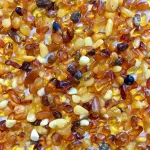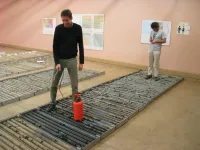(Press-News.org) WASHINGTON, April 5, 2021 -- For centuries, people in Baltic nations have used ancient amber for medicinal purposes. Even today, infants are given amber necklaces that they chew to relieve teething pain, and people put pulverized amber in elixirs and ointments for its purported anti-inflammatory and anti-infective properties. Now, scientists have pinpointed compounds that help explain Baltic amber's therapeutic effects and that could lead to new medicines to combat antibiotic-resistant infections.
The researchers will present their results today at the spring meeting of the American Chemical Society (ACS). ACS Spring 2021 is being held online April 5-30. Live sessions will be hosted April 5-16, and on-demand and networking content will continue through April 30. The meeting features nearly 9,000 presentations on a wide range of science topics.
Each year in the U.S., at least 2.8 million people get antibiotic-resistant infections, leading to 35,000 deaths, according to the U.S. Centers for Disease Control and Prevention. "We knew from previous research that there were substances in Baltic amber that might lead to new antibiotics, but they had not been systematically explored," says Elizabeth Ambrose, Ph.D., who is the principal investigator of the project. "We have now extracted and identified several compounds in Baltic amber that show activity against gram-positive, antibiotic-resistant bacteria."
Ambrose's interest originally stemmed from her Baltic heritage. While visiting family in Lithuania, she collected amber samples and heard stories about their medicinal uses. The Baltic Sea region contains the world's largest deposit of the material, which is fossilized resin formed about 44 million years ago. The resin oozed from now-extinct pines in the Sciadopityaceae family and acted as a defense against microorganisms such as bacteria and fungi, as well as herbivorous insects that would become trapped in the resin.
Ambrose and graduate student Connor McDermott, who are at the University of Minnesota, analyzed commercially available Baltic amber samples, in addition to some that Ambrose had collected. "One major challenge was preparing a homogeneous fine powder from the amber pebbles that could be extracted with solvents," McDermott explains. He used a tabletop jar rolling mill, in which the jar is filled with ceramic beads and amber pebbles and rotated on its side. Through trial and error, he determined the correct ratio of beads to pebbles to yield a semi-fine powder. Then, using various combinations of solvents and techniques, he filtered, concentrated and analyzed the amber powder extracts by gas chromatography-mass spectrometry (GC-MS).
Dozens of compounds were identified from the GC-MS spectra. The most interesting were abietic acid, dehydroabietic acid and palustric acid -- 20-carbon, three-ringed organic compounds with known biological activity. Because these compounds are difficult to purify, the researchers bought pure samples and sent them to a company that tested their activity against nine bacterial species, some of which are known to be antibiotic resistant.
"The most important finding is that these compounds are active against gram-positive bacteria, such as certain Staphylococcus aureus strains, but not gram-negative bacteria," McDermott says. Gram-positive bacteria have a less complex cell wall than gram-negative bacteria. "This implies that the composition of the bacterial membrane is important for the activity of the compounds," he says. McDermott also obtained a Japanese umbrella pine, the closest living species to the trees that produced the resin that became Baltic amber. He extracted resin from the needles and stem and identified sclarene, a molecule present in the extracts that could theoretically undergo chemical transformations to produce the bioactive compounds the researchers found in Baltic amber samples.
"We are excited to move forward with these results," Ambrose says. "Abietic acids and their derivatives are potentially an untapped source of new medicines, especially for treating infections caused by gram-positive bacteria, which are increasingly becoming resistant to known antibiotics."
INFORMATION:
A press conference on this topic will be held Monday, April 5, at 11 a.m. Eastern time online at http://www.acs.org/acsspring2021conferences.
The researchers acknowledge support and funding from the University of Minnesota Engebretson Drug Design and Development Grant and the Office of the Vice President for Research Grant-in-Aid of Research, Artistry, and Scholarship Program.
The American Chemical Society (ACS) is a nonprofit organization chartered by the U.S. Congress. ACS' mission is to advance the broader chemistry enterprise and its practitioners for the benefit of Earth and all its people. The Society is a global leader in promoting excellence in science education and providing access to chemistry-related information and research through its multiple research solutions, peer-reviewed journals, scientific conferences, eBooks and weekly news periodical Chemical & Engineering News. ACS journals are among the most cited, most trusted and most read within the scientific literature; however, ACS itself does not conduct chemical research. As a specialist in scientific information solutions (including SciFinder® and STN®), its CAS division powers global research, discovery and innovation. ACS' main offices are in Washington, D.C., and Columbus, Ohio.
To automatically receive news releases from the American Chemical Society, contact newsroom@acs.org.
Note to journalists: Please report that this research was presented at a meeting of the American Chemical Society.
Follow us: Twitter | Facebook
Title
Paleopharmaceuticals: Prospective drugs from Baltic amber
Abstract
Amber is formed through the fossilization of tree resin from various species of pine and pine-like trees over millions of years. The largest known deposits of amber, which originate from now extinct conifers of the family Sciadopityaceae, are located in the Baltic Sea region. Amber from this region, referred to as Baltic amber, has been used medicinally for centuries due to its immune-boosting, wound-healing, analgesic, anti-inflammatory, anti-infective, antifungal, and anticancer properties. Despite its well-established use in folk medicine, a comprehensive study of the bioactive constituents of Baltic amber has yet to be conducted to explain its therapeutic effects. Furthermore, fossils are an under investigated yet promising source of novel drug scaffolds due to the transformations that occur during the fossilization process and the different metabolic products generated by extinct species. Here we report optimized conditions for extraction and identification of compounds present in Baltic amber. We also present a comparison of the compounds extracted from samples of Baltic amber and Sciadopitys verticillata, the closest living relative to the extinct conifers that produced the resin that became Baltic amber. Finally, we report in vitro antibacterial activity data for parent structures of the identified compounds of interest.
DALLAS, April 5, 2021 -- When people with human immunodeficiency virus (HIV) develop high blood pressure, the type of medication chosen for their initial treatment may influence their risk of heart disease, stroke and heart failure, according to new research published today in Hypertension, an American Heart Association journal.
With current anti-retroviral medications, people with HIV are able to live longer. However, people with HIV receiving anti-retroviral therapy (ART) are more likely to develop high blood pressure (hypertension) and hypertension-related heart problems than people who do not have the virus. The current study is the first to examine how the choice of blood pressure medications influences the long-term risk of heart disease, stroke and ...
New research shows the permanent rise of oxygen in our atmosphere, which set the stage for life as we know it, happened 100 million years later than previously thought.
A significant rise in oxygen occurred about 2.43 billion years ago, marking the start of the Great Oxidation Episode -- a pivotal moment in Earth's history.
An international research team including a UC Riverside scientist analyzed rocks from South Africa formed during this event. Findings, published this week in the journal Nature, include the discovery that oxygen fluctuated dramatically after its early appearance until it became a permanent constituent of the atmosphere much later.
These ...
Researchers at the National Institutes of Health have developed a breath test that measures how well patients with methylmalonic acidemia (MMA) respond to receiving liver or combined liver and kidney transplantation. Researchers also used the test to assess the severity of the disease in people and help determine if they would benefit from surgical or experimental genomic therapies that target the liver. The study results were published in Genetics in Medicine. Scientists at the National Human Genome Research Institute (NHGRI) led the project team, with collaborators from the National ...
Rates of prolonged visits for pediatric mental health emergency department (ED) visits increased over a decade, in contrast to non-mental health visits for which visit times remained stable, according to a study published in the journal Pediatrics. From 2005-2015, rates of ED visits lasting over six hours for children presenting for mental health issues jumped from 16 percent to nearly 25 percent, while rates of visits lasting over 12 hours increased from 5 percent to nearly 13 percent.
"The trend of increasingly long ED visits for pediatric mental health problems likely represents worsening access to essential mental health services. This is concerning, especially since during the COVID-19 pandemic we are seeing substantially more children coming ...
BATON ROUGE, La. (March 2021) - Without restoration efforts in coastal Louisiana, marshes in the state could lose half of their current ability to store carbon in the soil over a period of 50 years, according to a new paper published in American Geophysical Union Journal of Geophysical Research Biogeosciences.
"This reduction in capacity could significantly alter the global carbon budget, given that Louisiana's marsh soils account for between 5 and 21 percent of the global soil carbon storage in tidally influenced wetlands," said Melissa Baustian, lead author and coastal ecologist at The Water Institute of the Gulf.
The article, "Long-term carbon sinks in marsh soils of coastal Louisiana are at risk to wetland loss" ...
A new study shows a correlation between the end of solar cycles and a switch from El Nino to La Nina conditions in the Pacific Ocean, suggesting that solar variability can drive seasonal weather variability on Earth.
If the connection outlined in the journal Earth and Space Science holds up, it could significantly improve the predictability of the largest El Nino and La Nina events, which have a number of seasonal climate effects over land. For example, the southern United States tends to be warmer and drier during a La Nina, while the northern U.S. tends to be colder ...
PULLMAN, Wash. - The ability to control your own behavior, known as executive function, might not exist all in your head. A new theory proposes that it develops with many influences from outside the mind.
The theory, detailed in Perspectives on Psychological Science, draws on dynamic systems theory which originated in mathematics and physics and has been used to describe complex organizing phenomena like cloud formation and flying patterns of birds. Now, a research team led by Washington State University human development assistant professor Sammy Perone is applying ...
Tokyo, Japan - Researchers from Tokyo Metropolitan University have shown that skeletal muscle satellite cells, key players in muscle repair, proliferate better in low glucose environments. This is contrary to conventional wisdom that says mammalian cells fare better when there is more sugar to fuel their activities. Because ultra-low glucose environments do not allow other cell types to proliferate, the team could produce pure cultures of satellite cells, potentially a significant boost for biomedical research.
Healthy muscles are an important part of a healthy life. With the wear and tear of everyday use, our muscles continuously repair themselves to keep them in top condition. In recent years, scientists have begun to understand how muscle repair ...
The neurons in our nervous system "talk" to each other by sending and receiving chemical messages called neurotransmitters. This communication is facilitated by cell membrane proteins called receptors, which pick up neurotransmitters and relay them across cells. In a recent study published in Nature Communications, scientists from Japan report their findings on the dynamics of receptors, which can enable understanding of the processes of memory formation and learning.
The regulation of receptor movement and localization within the neuron is important for synaptic plasticity, an important process in the central nervous system. A specific type of ...
DEPRIVATION among society at large is 'driving' Covid-19 disparities among minority ethnic groups - predominantly South Asian and Black African or Caribbean populations - and could be considered the main cause of disproportionate infection rates, hospitalisation and deaths experienced by these populations, according to new analysis from the University of Leicester.
The study, supported by the National Institute for Health Research (NIHR) Leicester Biomedical Research Centre (BRC) comes a day after a government-commissioned review concluded race and racism have become less important factors in explaining social disparities in the UK.
Researchers at the University of Leicester used UK Biobank data of 407,830 South Asian, Black ...



